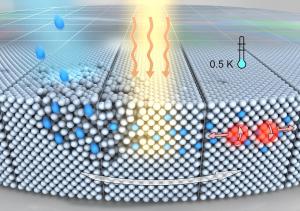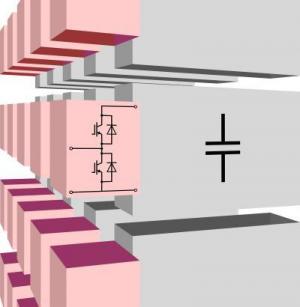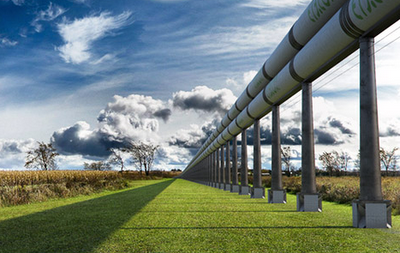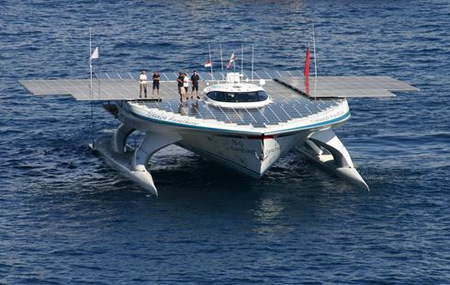Bend desk is a future technology which is exactly like a touch screen but have cured surface and multiple new capabilities over simple touch screen. It allows multitasking and multiple user interfacing in the same time. The folks at Media Computing Group have recently re-defined their latest technology BendDesk. This is truly cutting-edge stuff. BendDesk is a multi-touch desk environment that seamlessly combines a vertical and a horizontal touch surface with a curve into one large interactive workspace. Before you start wondering whether this is just another never-to-see-day-of-light concept, we can tell you its not only just an idea anymore.
It is fully functional screen in which you can perform function by physical manipulating the screen. It recognize the multi-touch gestures. the video demo given below gives you more understanding about the interface of this technology. We hope that this technology require few years.
News

Superconductors are substances that conduct electricity without losses when cooled down to very low temperatures. Pure semiconductors, like silicon or germanium, are almost non-conducting at low temperatures, but transform into conducting materials after doping with foreign atoms. An established method of doping is ion implantation (ions = charged atoms) by which foreign ions are embedded into the crystal lattice of a semiconductor. To produce a superconducting semiconductor, an extreme amount of foreign atoms are necessary, even more than the substance would usually be able to absorb. At the FZD, germanium samples were doped with about six gallium atoms per 100 germanium atoms. With these experiments, the scientists could prove indeed that the doped germanium layer of only sixty nanometers thickness became superconducting, and not just the clusters of foreign atoms which could easily form during extreme doping .
As the germanium lattice is heavily damaged by ion implantation, it has to be repaired afterwards. For such purposes, a flash-lamp annealing facility has been developed at the FZD. Its application allows for a repair of the destroyed crystal lattice by rapidly heating the sample surface (within few milliseconds) while the distribution of the dopant atoms is kept almost the same.
From a scientific point of view, the new material is very promising. It exhibits a surprisingly high critical magnetic field with respect to the temperature where the substance becomes superconducting. For many materials, superconductivity occurs only at very low temperatures, slightly above the absolute zero point of -273 degrees Celsius or 0 Kelvin. The gallium doped germanium samples become superconducting at about 0.5 Kelvin; however, the FZD researchers expect the temperature to increase further by changing various parameters during ion implantation or annealing.
Physicists have been dreaming about superconducting semiconductors for a long time, but saw only few chances for the semiconductor germanium to become superconducting at all. Germanium used to be the material for the first generation of transistors; however, it was soon replaced by silicon, the current material for microelectronics. Recently, the “old” semiconductor material germanium has aroused more and more interest, as it allows, compared to silicon, for more rapid circuits.
Experts even believe germanium to be rediscovered for micro- and nanoelectronics. The reason for such a renaissance lies in the fact that miniaturization in microelectronics industry using silicon is coming to an end. Today, extremely thin oxide layers are needed for transistors, down to a level where silicon oxide does not work well any more. Germanium as a new material for chips would come along with two big advantages: it would enable both faster processes and further miniaturization in micro- and nanoelectronics. Superconducting germanium could thus help to realize circuits for novel computers.
The scientists at the Forschungszentrum Dresden-Rossendorf followed a targeted approach when searching for a new superconducting semiconductor. Instead of doping with boron, which had resulted in superconducting silicon two years ago in France, the scientists choose gallium because of its higher solubility in germanium. In many systematic experiments they proved that the superconductivity of germanium can be reproduced. Furthermore, they were able to show that the transition temperature marking the start of superconductivity can be raised within certain limits.
In the future, the scientists at the two FZD institutes “Ion Beam Physics and Materials Research” and “Dresden High Magnetic Field Laboratory” will combine their know-how in order to fine-tune different rather complex parameters for further experiments, thus hopefully discovering further mysteries of superconducting semiconductors.
Story Source:
The above story is reprinted from materials provided by Forschungszentrum Dresden Rossendorf.
 Power Grid of the Future Saves Energy | Power Grid Saves Energy, Cars and trucks race down the highway, turn off into town, wait at traffic lights and move slowly through side streets. Electricity flows in a similar way — from the power plant via high voltage lines to transformer substations. The flow is controlled as if by traffic lights. Cables then take the electricity into the city centre. Numerous switching points reduce the voltage, so that equipment can tap into the electricity at low voltage. Thanks to this highly complex infrastructure, the electricity customer can use all kinds of electrical devices just by switching them on.
Power Grid of the Future Saves Energy | Power Grid Saves Energy, Cars and trucks race down the highway, turn off into town, wait at traffic lights and move slowly through side streets. Electricity flows in a similar way — from the power plant via high voltage lines to transformer substations. The flow is controlled as if by traffic lights. Cables then take the electricity into the city centre. Numerous switching points reduce the voltage, so that equipment can tap into the electricity at low voltage. Thanks to this highly complex infrastructure, the electricity customer can use all kinds of electrical devices just by switching them on.
“A reliable power supply is the key to all this, and major changes will take place in the coming years to safeguard this reliability. The transport and power networks will grow together more strongly as a result of electromobility, because electric vehicles will not only tank up on electricity but will also make their batteries available to the power grid as storage devices. Renewable energy sources will become available on a wider scale, with individual households also contributing electricity they have generated,” says Professor Lothar Frey, Director of the Fraunhofer Institute for Integrated Systems and Device Technology IISB in Erlangen.
In major projects such as Desertec, solar thermal power plants in sun-rich regions of North Africa and the Middle East will in the future produce electricity for Europe. The energy will then flow to the consumer via long high-voltage power lines or undersea cables. The existing cables, systems and components need to be adapted to the future energy mix now, so that the electricity will get to the consumer as reliably and with as few losses as possible. The power electronics experts at the IISB are working on technological solutions, and are developing components for the efficient conversion of electrical energy.
For energy transmission over distances of more than 500 kilometers or for undersea cables direct current is being increasingly used. This possesses a constant voltage and only loses up to seven percent of its energy over long distances. By comparison, the loss rate for alternating current can reach 40 percent. Additional converter stations are, however, required to convert the high voltage of the direct current into the alternating current needed by the consumer.
“In cooperation with Siemens Energy we are developing high-power switches. These are necessary for transmitting the direct voltage in the power grid and are crucial for projects like Desertec. The switches have to be more reliable, more scaleable and more versatile than previous solutions in order to meet the requirements of future energy supply networks,” says Dipl.-Ing. Markus Billmann from the IISB. To this end, the research scientists are using low-cost semiconductor cells which with previous switching techniques could not be used for high-voltage direct-current transmission (HVDCT).
“At each end of a HVDCT system there is a converter station,” explains the research scientist. “For the converters we use interruptible devices which can be operated at higher switching frequencies, resulting in smaller systems that are easier to control.” A major challenge is to protect the cells from damage. Each converter station will contain about 5,000 modules, connected in series, and if more than a few of them failed at the same time and affected their neighboring modules a chain reaction could be triggered which would destroy the entire station. “We have now solved this problem. With our cooperation partners we are working on tailor-made materials and components so that in future the equipment will need less energy,” says Billmann.
Story Source:
The above story is reprinted from materials provided by Fraunhofer-Gesellschaft.
Tags : Power Grid of the Future Saves Energy , Power Grid , Power Grid of the Future , Power Grid of the Future Saves Energy
Think of the actual bus as like a skytrain on a tramline. One thing is for sure, this bus won’t get in your way and it won’t look anything like the buses you’ve seen in any other country and drivers can be sure to feel disorientated when they drive under it, much like driving through a tunnel. Check it out in the video below, translation can be found just beneath it thanks to the folks at Chinahush…
What you can see from the video is traffic jams, what you can hear is noise, and there is also invisible air pollution. At present, there are mainly 4 types of public transits in China: subway, light-rail train, BRT, and normal bus. They have advantages and disadvantages, for example, subway costs a lot and takes long time to build; BRT takes up road spaces and produces noises as well as pollution to the air. How to develop environmental-friendly public transportation? Straddling bus provides a solution. Let’s watch a demonstration.
The straddling bus combines the advantages of BRT, it is also a substitution for BRT and subway in the future. As you all know, the majority vehicle on the road is car, the shortest vehicle is also car. Normally our overpass is 4.5-5.5 m high. The highlight innovation of straddling bus is that it runs above car and under overpass. Its biggest strength is saving road spaces, efficient and high in capacity. It can reduce up to 25-30% traffic jams on main routes. Running at an average 40 km/h, it can take 1200 people at a time, which means 300 passengers per cart.
Another strength of straddling bus is its short construction life cycle: only 1 year to build 40 km. Whereas building 40-km subway will take 3 years at best. Also the straddling bus will not need the large parking lot that normal buses demand. It can park at its own stop without affecting the passage of cars. This is what the interior looks like: it has huge skylight that will eliminate passengers’ sense of depression when enter.
There are two parts in building the straddling bus. One is remodeling the road, the other is building station platforms. Two ways to remodel the road: we can go with laying rails on both sides of car lane, which save 30% energy; or we can paint two white lines on both sides and use auto-pilot technology in the bus, which will follow the lines and run stable.
There are also two ways in dealing with station platform. One is to load/unload through the sides; the other is using the built-in ladder so that passengers can go up and to the overpass through the ceiling door.
Straddling bus is completely powered by municipal electricity and solar energy system. In terms of electricity, the setting is called relay direct current electrification. The bus itself is electrical conductor, two rails built on top to allow the charging post to run along with the bus, the next charging post will be on the rails before the earlier one leaves, that is why we call it relay charging. It is new invention, not available yet in other places.
The set here is super capacitor, a device that can charge, discharge and store electricity quickly. The power it stores during the stop can support the bus till the next stop where another round of charging takes place, achieving zero toxic gas throughout the process.
About the ultrasonic waves put forth from the end of the bus, that is to keep those high cars or trucks away from entering the tunnel. Using laser ray to scan, cars get too close to the passage will activate the alarm on the bus end. Inside the bus, there are turning lights that indicate a the bus is intending to make a turn to warn the cars inside. Also radar scanning system is embedded on the walls to warn cars from getting too close to the bus wheels.
Nowadays many big cities have remodeled their traffic signaling system, to prioritize public buses, that is to say when a bus reaches a crossing, red light on the other side of the fork will turn on automatically to give buses the right of way. Our straddling bus can learn from this BRT method. The car can make the turn with the bus if that is the direction it wants to go too; if not, the red light will be on to stop the cars beneath while the bus take the turn.
The bus is 6 m in width and 4-4.5 m high. How will people get off the bus if an accident happens to such a huge bus? Here I introduce the most advanced escaping system in the world. In the case of fire or other emergencies, the escaping door will open automatically. I believe many of you have been on a plane. Planes are equipped with inflated ladder so people can slide down on it in emergency. I put the escaping concept into the straddling bus. It is the fastest way to escape.
The bus can save up to 860 ton of fuel per year, reducing 2,640 ton of carbon emission. Presently we have passed the first stage demonstration and will get through all of the technical invalidation by the end of August. Beijing’s Mentougou District is carrying out a eco-community project, it has already planned out 186 km for our straddling bus. Construction will begin at year end.
Thank you.
 A new and helpful invention in the world of robotics is badminton playing robot named JADA. As we all know that badminton is the world’s fastest and difficult game after table tennis. The invention of this robot helps the professionals to train their-self in a much better and accurate way. The video below will entertains you about JADA:
A new and helpful invention in the world of robotics is badminton playing robot named JADA. As we all know that badminton is the world’s fastest and difficult game after table tennis. The invention of this robot helps the professionals to train their-self in a much better and accurate way. The video below will entertains you about JADA:
 Now you can imagine the space traveling experience on the earth, the future of transportation is ET3(Evacuated Tube Transport Technologies). This mode of transportation is clean, green, fast, comfortable, safe, faster and affordable.
Now you can imagine the space traveling experience on the earth, the future of transportation is ET3(Evacuated Tube Transport Technologies). This mode of transportation is clean, green, fast, comfortable, safe, faster and affordable.
The traveling time for New york to Beijing is 13 hours 30 minutes through flight while through this technology this time will reduces to 2 hours
The working of ET3 is explained below:
Car sized passenger capsules travel in 1.5m (5′) diameter tubes on frictionless maglev. Air is permanently removed from the two-way tubes that are built along a travel route. Airlocks at stations allow transfer of capsules without admitting air. Linear electric motors accelerate the capsules, which then coast through the vacuum for the remainder of the trip using no additional power. Most of the energy is regenerated as the capsules slow down. ET3 can provide 50 times more transportation per kWh than electric cars or trains.
Speed in initial ET3 systems is 600km/h (370 mph) for in state trips, and will be developed to 6,500 km/h (4,000 mph) for international travel that will allow passenger or cargo travel from New York to Beijing in 2 hours. ET3 is networked like freeways, except the capsules are automatically routed from origin to destination.
 This is what the future of transportation.
This is what the future of transportation.
For more explanation about the ET3 technology watch the video below:


